
|

|
|
Home Site Search Contact Us Subscribe
|
|
Quiet and Disquiet Together: A Quarantine-Induced Assessment of Downtown Manhattan We savor the city, lingering on the rich detail, walking down streets that we neglected in busier times. It does feel like the proverbial music has stopped. How could it not? Hopefully we'll emerge from our collective timeout recommitted to creating a more equitable and resilient city. By Dan Kaplan, FAIA, LEED AP May 28, 2020 Early spring is the magic-light time in Manhattan. The orientation of the grid allows the low angle of the sun to caress the (still) predominantly masonry bas-relief of architectural surfaces. During this season, north-facing façades (Manhattan-north, not true-north) get their yearly dose of direct sun, creating surprising shadows. The street trees are haloed in a delicate green. Sunsets are especially vibrant, now even more so with the dramatic improvement in air quality born from the near-complete cessation of economic activity.
We didn’t escape to the Hamptons or the Hudson Valley, but rather chose to remain in our cheerful apartment in Greenwich Village. I think it’s because we somewhat recently returned to the city from the suburbs, and rekindled our love for the neighborhood. We feel compelled to stay and bear witness.
The iconic neighborhoods of Lower Manhattan (the “Downtown” of the 1970s and ‘80s) have, by and large, seen fewer cases than the outer boros. The New York Times’ cases-by-zip-code charts paint a picture of relative calm in a sea of woe. This is most certainly a reflection of affluence: many of the neighborhood’s residents have decamped to country houses; those who stayed put have the privilege of not being on the front lines of service industries (now belatedly appreciated), and continue their work from large-ish apartments, enabled by the internet-borne wonders of Zoom, Facetime, and Teams. NYU, Cooper Union, and Parsons students have scattered, taking with them their fluorescent hair, skateboards, and gender non-binary fashion. The shops and businesses that provide the Jane Jacobs (really, more Marc than Jane) street ballet are shuttered. The gentle babble of tourists, especially the Italians, French, and Israelis who flock to the city during this season of religious renewal (and spring vacation), is, of course, gone.
Amid this combination of early spring expansiveness and mournful emptiness, my wife and I have been taking long walks wearing our home-sewn, high-thread-count facemasks. After an entire day shuttling between virtual meetings, we luxuriate in the late afternoon light and take in the long view, one infinitely further – and more satisfying – than the computer screen a mere 18 inches away. We savor the city, lingering on the rich detail, walking down streets that we neglected in busier times. These walks are a respite, allowing for slow contemplation, a sort of mindful flânerie.
On these walks, it does feel like the proverbial music has stopped. How could it not? We have just lived through one of the largest building booms that transform New York in periodic spasms. In the two decades since 9/11, the city has changed so much, both physically and culturally. A frenzy of real estate, low interest rates, the advent of big tech (and its NYC cousin, FinTech), and an almost worshipful celebration of urban sensibilities gave these decades their vibe. Now, all has been brought to an induced societal coma in an attempt to flatten the curve. Like coming downstairs the morning after a roaring party and sorting through the aftermath, stock-taking is the natural urge. So, what have we wrought? What has our generation’s building boom contributed?
Nowhere is the transformation of Manhattan more striking and evident than its new western edge running from 59th Street to the Battery. This is the new façade of the island, in large measure initiated by the visionary trio of Bloomberg, Burden, and Doctoroff. The obvious first impression: this is now a glass city, no longer a masonry city (or at least it has new a glass front). The all-glass fever (a global phenomenon) is to high-rise architecture what CGI is to film, hops is to beer-making, or salt is to caramel. In masterful hands (say a Renzo Piano or Fumihiko Maki) it can be magical; for most of the rest of us, it’s a lazy default. Contrary to the sparkling, lithe promise of the renderings, most glass buildings are dark and brooding. Exhibit A of course, is the Oz that is Hudson Yards (KPF, et al) and Manhattan West (SOM). From some downtown vantage points (especially due south), it is possible to discern a glimpse of an imaginative new mega-urbanism in the development. Currently, though, the buildings are a bit like interlopers and will need a generation to feel like they belong.
The more modest collection of glassy office buildings in the Meatpacking District by Studio Gang and James Carpenter, with their exquisite crafting, can leave one a bit cold. It’s a matter of simple optics: all that transparency enables an unobstructed view into the building’s interior that is in perpetual shadow from its own floors. Of course, there are exceptions: Zaha Hadid’s final curving opus facing the High Line on 28th Street and Herzog & de Meuron’s 420 Leroy Street. These two sinuous designs have transcended the transparency trap through a dose of opaque materiality and elegant, high-wire tectonics.
As one walks through the collection of Historic Districts south of 23rd Street, it seems that one of the great contributions of the Landmarks Preservation Commission has been to force architects to rediscover the joys of designing frames and surfaces. SoHo, in particular, has become a laboratory of this. From the neo- Gaudí, anthropomorphic XOCO by DDG to the substantial yet inventive and lovingly crafted 150 Wooster by KUB, there are some wonderful, thoughtful additions to the richly textured cityscape. (An aside: Both DDG and KUB are architect-developers – just a coincidence?) NoHo too, has seen wonderful additions to the cityscape, Annabelle Selldorf’s 10 Bond Street and BKSK’s 25 Bond, in particular.
We return again and again to the textures of these great downtown neighborhoods with their ever-unfolding streetscapes: Chelsea, SoHo, NoHo, the Village (plus East and West), Flatiron, Gramercy, Tribeca. All of the new infill and renovation have created a tidied-up, polished version of their formerly funky selves. We marvel at the cumulative effect, especially on the side streets, where it is possible to escape the sadness of the shuttered storefronts. West 21st Street is but one example of many. Walking west from the Flatiron, through Ladies’ Mile and Chelsea, there is a joy in the variety and layers: the handsome old and new lofts, the renovated Theological Seminary, the rows of townhouses. 433 West 21st Street (Springsteen & Goldhammer, 1930) is a wonderful discovery. With its wonderful brick work (with whiffs of the Amsterdam School) and generous sash windows, it’s perfectly balanced between the moderne and the modern. Who wouldn’t want to shelter-in-place there?
Emerging onto Tenth Avenue, we are jarred out of our side-street reverie by a pair of duos: BIG - Bjarke Ingels Group’s XI leaning towers and Heatherwick’s Lantern Houses. Jettisoning the careful, generous, and in some regards, humble discipline of city-building, these two are so clearly unfettered exercises in brand-building. A few decades hence, when it’s just as likely as not that they’ll be chopped up into “studios and ones,” will they be as desirable as Springsteen & Goldhammer’s perch on 21st Street? So much of this new stretch of the West Side is a world born of self-centeredness, or as Colin Rowe use to say, object fixation. The area west of Tenth Avenue is less a neighborhood and more a curated collection of individual buildings strung together by the High Line. I am not confident that history will look kindly on it.
A lesson worth relearning: it’s all about the public realm. Yes, the High Line itself is exciting, inventive, and at times magical. But it is closed, in a temporary return to its prelapsarian (and pre-fetishized) state. The Hudson River Park (Mathews Nielsen and Quennell Rothschild), the High Line’s less celebrated sibling, is seeing its day in the sun. Here, the denizens of quarantine come out, blinking in the late afternoon sunlight, finding ample spaces to escape their screens and stresses for some socially-distanced recreation along the water. From the planted and programmed piers that jut into the Hudson, to the bike paths and the substantially built esplanades that skirt it, it’s all terrific. To get from the Village to Hudson River Park, one walks through streets that have been relentlessly improved: more trees (some with bioswales!), more bike lanes, less traffic islands, less roadbed. There are other parks along the way, well-tended and functioning as the societal levelers that they were envisioned to be, with Washington Square Park the crown jewel. Reaching the river, there is evidence of an imaginative civic infrastructure. WXY/Dattner’s salt shed and the FDNY Marine 1 Pier by CR Studio stand out. Heatherwick’s Pier 55 (a.k.s. Diller Island), suspended in the mid-throes of construction, is looking promising. A celebration of place and repose with a good dose of fantasy, it will clearly be Heatherwick’s best, most welcoming contribution to New York.
From the new and burnished parks to the reinvented streetscape and invigorated infrastructure – these will be the most important and beloved legacies of this boom. For their hard work to elevate the Commons, I am grateful to and proud of my contemporaries.
This dedication to the commonweal points to a way forward. The pandemic has revealed in painful, tragic clarity the frayed capacity of our resource-starved public institutions and the deeply inequitable distribution of what they deliver. In the torrent of COVID-related commentary, I read a missive that stuck: “It's as if Mother Nature has sent us all to our rooms to think about what we have done” [Bill Weir, CNN Chief Climate Correspondent]. Hopefully we’ll emerge from our collective timeout recommitted to creating a more equitable and resilient city. The wonders of a Diller Island or the embracing comfort of a West Village should be found equally in an East New York or a Parkchester. New York’s civic infrastructure of hospitals, homeless services, and elderly housing – not to mention the long-suffering transportation network – need our collective investment of money and imagination. As we do so, let’s leverage an interconnected, intersectional mindset to create housing that will improve public health; transportation that will level the economic playing field; and parks that will increase the city’s resiliency to rising tides and a warming planet.
As many have pointed out, the pandemic is the official trailer for the horror movie that is climate change. We must strengthen our resolve to think about the unthinkable – and then make a robust response to it. These quiet walks through my wounded city have made it clear that many have “paid it forward” with vision, expertise, labor, and collaboration. Now, it’s our turn.
Dan Kaplan, FAIA, LEED AP, is senior partner at FXCollaborative, where he serves in a design and leadership capacity for many of the firm's complex, award-winning urban projects. He has achieved both national and international acclaim for his design excellence by numerous organizations and publications, including the American Institute of Architects, Architectural Review, and the Boston Society of Architects.
|
(click on pictures to enlarge)  Kristen Richards Lower Manhattan – from afar 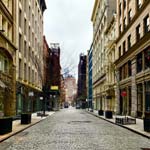 A deserted Greene Street, late afternoon, flat light 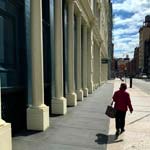 Dan Kaplan Soho, Sunday, March 15th. Solitary figure on normally packed sidewalks 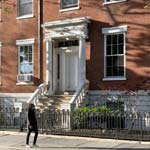 Dan Kaplan Late afternoon light on the Washington Square North 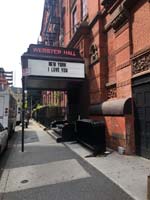 Tami Hausman Webster Hall, in the East Village, posts a message of hope amid the pandemic: “New York, I Love You.” 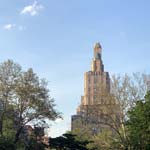 Dan Kaplan One Fifth Avenue (Harvey Wiley Corbet, 1927) in spring light. No one has really come close to a perfect medium-tall apartment house since. 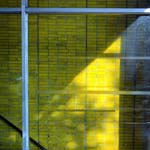 Dan Kaplan Glazed yellow brick, Washington Square Village (S.J. Kessler Architects, 1958) 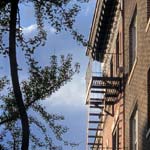 Dan Kaplan Late afternoon, West Village 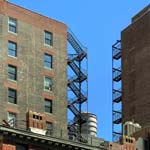 Dan Kaplan Park Avenue South: the background texture of New York – fire escapes, party walls, and wooden water tanks |
© 2020 ArchNewsNow.com